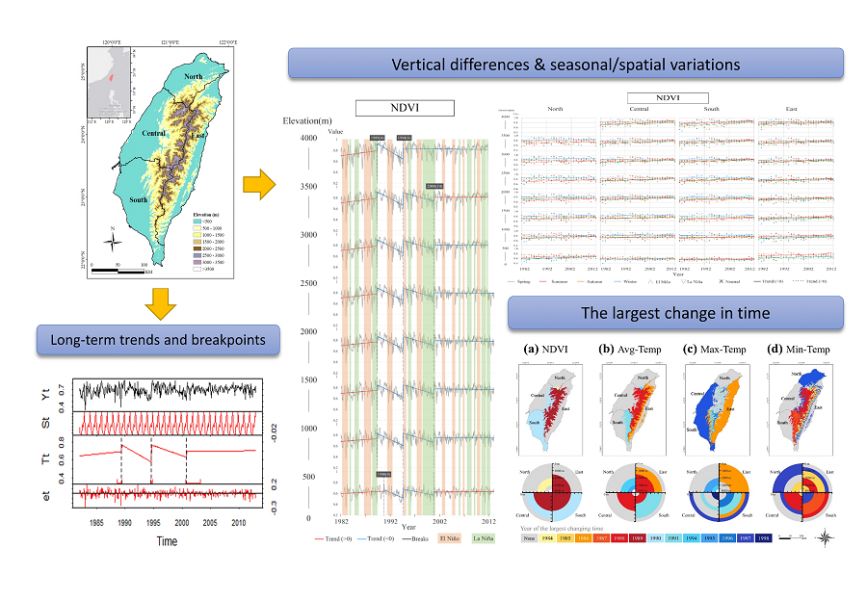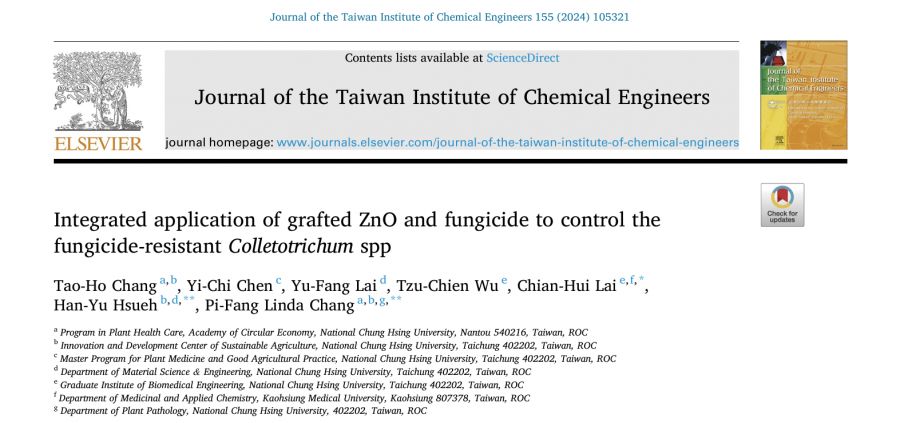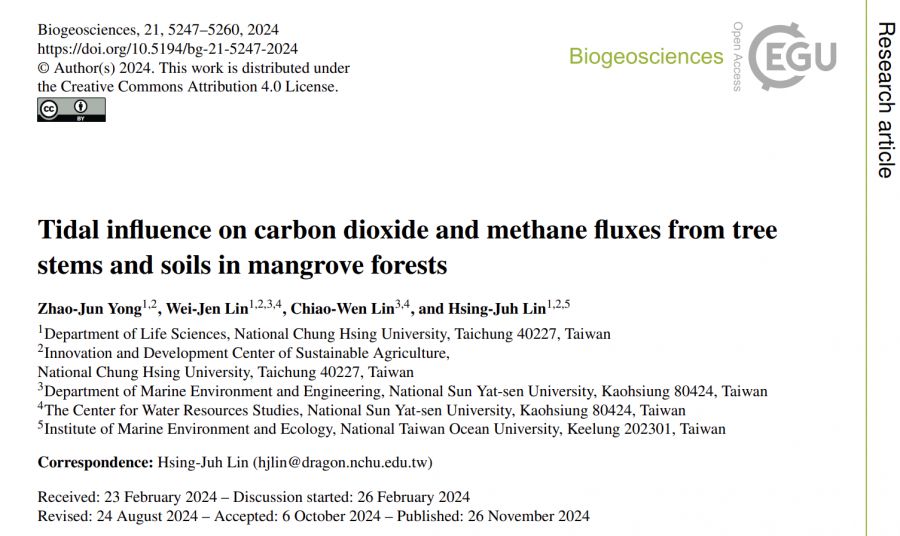生態農業:農業地景生態監測及復育【土木工程學系/蔡慧萍副教授】
| 論文篇名 | 英文:Vertical Differences in the Long-Term Trends and Breakpoints of NDVI and Climate Factors in Taiwan 中文:臺灣植被和氣候因子的長期趨勢與轉折點之垂直高程差異 |
| 期刊名稱 | REMOTE SENSING |
| 發表年份,卷數,起迄頁數 | 2021, 13(22), 4707 |
| 作者 | Tsai, Hui Ping(蔡慧萍)*; Wang, Geng-Gui; Zhuang, Zhong-Han |
| DOI | 10.3390/rs13224707 |
| 中文摘要 | 由於臺灣地形的高度變化大,因此本研究從垂直高程的觀點,探討30年來(1982年至2012年)整體與區域性植被、降雨和溫度的長期趨勢和斷點,希望能更瞭解其長期動態的變化。具體而言,本研究以高分辨率輻射計(AVHRR)常態化差異植被指數(NDVI)數據和臺灣氣候變遷推估資訊與調適知識平台(TCCIP)網格化的月尺度氣候數據之時間序列,採用季節和趨勢轉折點(BFAST)演算法、Pearson相關分析和Durbin-Watson演算法探討在不同高程區段內植被與氣候因子的長期動態。 本研究發現植被NDVI數值在大多數高程區段中都一致呈現三個斷點,且趨勢由正(1982-1989)轉為負,並在2000年後逐漸轉正。此外,降雨為增加趨勢;平均溫和最高溫為上升趨勢;最低溫則變化較多,尤其是在高海拔地區。從區域差異看,北部植被生長平穩,中部植被生長較差。較高的海拔的NDVI、平均溫與最低溫變化較大。其中,最低氣溫升高現象於東部和中部地區的中高海拔地區較明顯。在季節性變化方面,發現乾季和雨季的差異越來越大,北部地區差異最小,南部地區差異最大。植被NDVI和氣候因子的相關性多為負相關,但最高溫和最低溫在500 m以下的低海拔地區為顯著正相關;北部和中部地區相似,而南部和東部地區則對氣候因子有不同的的反饋。本研究探討臺灣植被和氣候因素的長期動態關係,也從其中發現了氣候變遷的趨勢,研究成果可做為臺灣制定相應的氣候適應策略參考。 |
| 英文摘要 | This study explored the long-term trends and breakpoints of vegetation, rainfall, and temperature in Taiwan from overall and regional perspectives in terms of vertical differences from 1982 to 2012. With time-series Advanced Very-High-Resolution Radiometer (AVHRR) normalized difference vegetation index (NDVI) data and Taiwan Climate Change Estimate and Information Platform (TCCIP) gridded monthly climatic data, their vertical dynamics were investigated by employing the Breaks for Additive Seasonal and Trend (BFAST) algorithm, Pearson’s correlation analysis, and the Durbin–Watson test. The vertical differences in NDVI values presented three breakpoints and a consistent trend from positive (1982 to 1989) to negative at varied rates, and then gradually increased after 2000. In addition, a positive rainfall trend was discovered. Average and maximum temperature had similar increasing trends, while minimum temperature showed variations, especially at higher altitudes. In terms of regional variations, the vegetation growth was stable in the north but worse in the central region. Higher elevations revealed larger variations in the NDVI and temperature datasets. NDVI, along with average and minimum temperature, showed their largest changes earlier in higher altitude areas. Specifically, the increasing minimum temperature direction was more prominent in the mid-to-high-altitude areas in the eastern and central regions. Seasonal variations were observed for each region. The difference between the dry and wet seasons is becoming larger, with the smallest difference in the northern region and the largest difference in the southern region. Taiwan’s NDVI and climatic factors have a significant negative correlation (p < 0.05), but the maximum and minimum temperatures have significant positive effects at low altitudes below 500 m. The northern and central regions reveal similar responses, while the south and east display different feedbacks. The results illuminate climate change evidence from assessment of the long-term dynamics of vegetation and climatic factors, providing valuable references for establishing correspondent climate-adaptive strategies in Taiwan. |
| 發表成果與本中心研究主題相關性 | 此研究以地景生態的角度,針對臺灣地形高度變化大的地形特徵,進行不同高程區段內植被與氣候因子的長期動態分析,討論長期環境因子與植被的交互關係,也進而發現了氣候變遷的趨勢,有助於台灣生態環境資源保育之永續管理,符合永續農業創新發展研究主軸。 |







